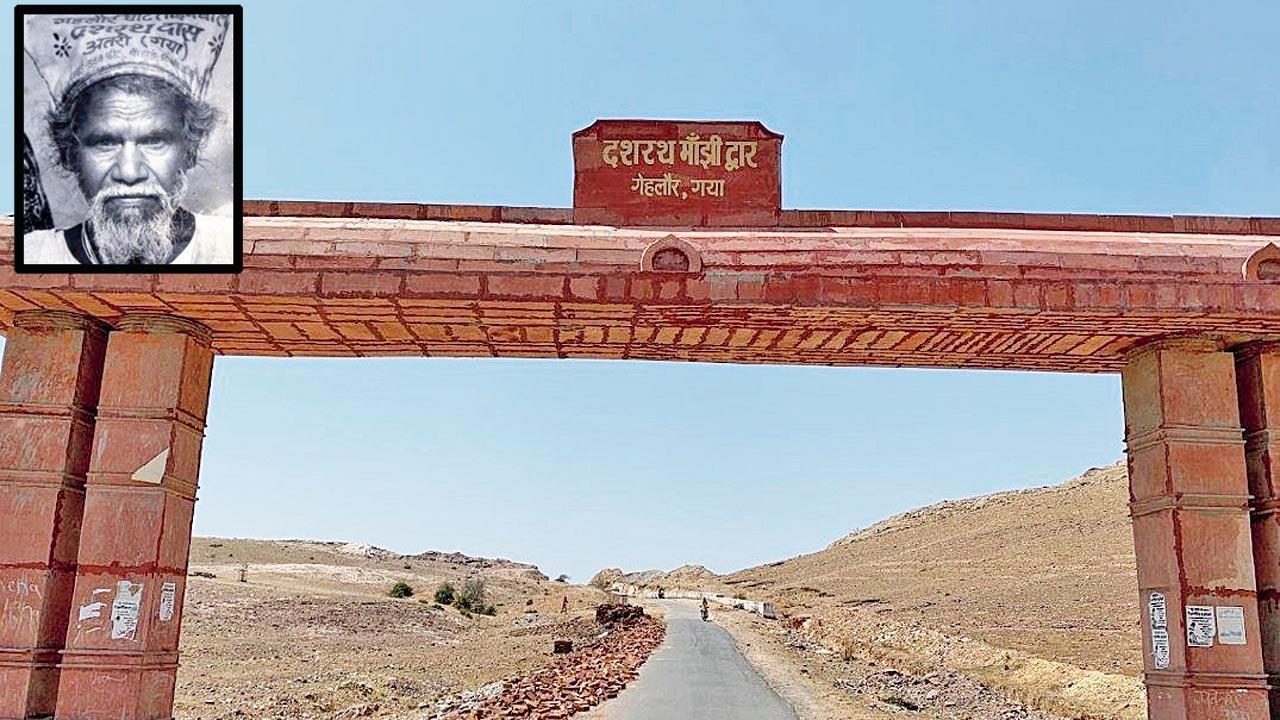Dashrath Manjhi’s wife fell off a mountain and died because she couldn’t get to a doctor in time. What Dashrath did next is a lesson in the power of love

Dashrath Manjhi (inset) Dwar in Gehlor, Bihar. Pics/Twitter
 They say that given enough time, a steadily dripping drop of water can wear down a giant rock. They also say that true love can move mountains. The story of a humble Indian called Dashrath Manjhi reminded me of both these aphorisms.
They say that given enough time, a steadily dripping drop of water can wear down a giant rock. They also say that true love can move mountains. The story of a humble Indian called Dashrath Manjhi reminded me of both these aphorisms.
ADVERTISEMENT
I’d heard of Shah Jahan and how he built the Taj Mahal for his beloved wife Mumtaz Begum. I’ve heard of the so-called Taj Mahal of the North—the Ashton Memorial in Lancaster, England. The 150-foot structure, not marble but Portland stone with a copper dome, was the loving memorial of local millionaire Lord Ashton to his second wife Jessie, who died in 1904.
In an age where marriage is going out of style and divorces are seen as inevitable, we still feel a twinge when we read about the things people do in the name of love. But Dashrath’s monument to his wife teaches us that it’s not only millionaires and kings who can immortalise their loved ones.
Some people in Bihar’s Gehlor village will tell you that Dashrath used to be a miner, while others may remember him as an agricultural labourer. He was both in the course of his 73 years of life but they neither made him rich nor famous.
Where he was born, it mattered that he belonged to the lowest of castes. As a young lad at the bottom of the social barrel, he ran away from home looking for opportunity but the best he found were hundreds of feet below the earth in the blazing coal mines of Dhanbad. He returned to Gehlor to become a farm hand.
Somewhere around this time, he married Falguni. It is not known whether it was love or arrangement. From pictures I’ve seen of Dashrath, I’d guess that he was a man of few words. He looks taciturn, not the kind who’d produce poetry or declarations of undying love. His hands and heels would have been callused from work.
Gehlor village sits on a plain, but to its south rises a steep quartzite ridge reckoned to be over a billion years old, and today counted as part of the Rajgir Hills. On the other side of the hill lay the town of Wazirganj; to get there you had to go over or around the mountain.
One day in 1959, Dashrath’s wife Falguni, carrying lunch for him, fell off that mountain and was severely injured. The nearest town with a doctor was 90 kms away on the other side of the mountain and no transport was available. Falguni died before she could receive medical help.
We can only imagine Dashrath’s grief because he would have borne this wound, like every other wound life had inflicted on him, with stoic silence. I don’t think he would have shed tears or beaten his chest with bereavement.
From great grief comes great inspiration, as it did for Shah Jahan. Dashrath decided that in memory of his beloved Falguni, he would cut a road through the mountains so that no one else would ever fall and die again because they could not reach a hospital in time.
However, unlike Shah Jahan or Lord Ashton, Dashrath was penniless and unemployed—he couldn’t hire bulldozers and earthmovers or an army of workers to cleave the mountain in two. Dashrath decided to build the road by himself with the only tools he owned.
Those tools happened to be a hammer and a chisel.
The whole village laughed at this foolish man and his hare-brained plan. Only an idiot would think anyone could cut a road through a mountain with two hand tools.
“They called me a lunatic when I started hammering the hill,” Dashrath said later. But that only made him more dogged.
The laughter of the villagers died down in a few years when they saw his grim resolve. Some began to call him the ‘Mountain Man’. Some of the villagers who had taunted him began to support him by bringing him food or buying him tools.
Dashrath chipped away at the mountain for 22 years. When he was done, he had carved a path—110 metres long, 7.7 metres deep in places and 9.1 metres wide—through a ridge of rocks. The villagers weren’t ridiculing him any more. He had shown them that one determined man can move a mountain even with just a hammer and a chisel.
In 2007, Manjhi was diagnosed with gallbladder cancer. He died on 17 August, 2007 at the All India Institutes of Medical Sciences in New Delhi and was given a state funeral by the government of Bihar. A proper road now connects Gehlor with Wazirganj and Atri, in Gaya district.
The India Post department released a commemorative stamp featuring Dashrath Manjhi in December 2016. Now that’s more than Shah Jahan ever got when he made the Taj Mahal.
Here, viewed from there. C Y Gopinath, in Bangkok, throws unique light and shadows on Mumbai, the city that raised him. You can reach him at cygopi@gmail.com
Send your feedback to mailbag@mid-day.com
The views expressed in this column are the individual’s and don’t represent those of the paper
 Subscribe today by clicking the link and stay updated with the latest news!" Click here!
Subscribe today by clicking the link and stay updated with the latest news!" Click here!







